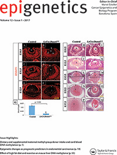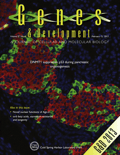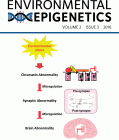
Epigenetics
Scope & Guideline
Bridging the Gap Between Genetics and Disease
Introduction
Aims and Scopes
- Investigation of DNA Methylation and Gene Expression:
The journal extensively covers research on how DNA methylation patterns influence gene expression, providing insights into the biological processes underlying development, disease, and environmental responses. - Epigenetic Regulation Mechanisms:
Papers published often explore various mechanisms of epigenetic regulation, including histone modifications, non-coding RNAs, and chromatin remodeling, contributing to a deeper understanding of gene regulation. - Clinical Implications and Biomarkers:
Research often focuses on the identification of epigenetic biomarkers for disease diagnosis, prognosis, and treatment, highlighting the translational aspect of epigenetic studies in clinical settings. - Transgenerational Epigenetic Inheritance:
The journal includes studies that investigate how epigenetic modifications can be inherited across generations, shedding light on the implications for developmental biology and evolutionary processes. - Environmental and Lifestyle Factors:
Research is frequently centered on the impact of environmental exposures and lifestyle choices on epigenetic modifications, emphasizing the interplay between genetics and the environment.
Trending and Emerging
- Role of m6A RNA Modifications:
There is an increasing focus on N6-methyladenosine (m6A) modifications in RNA and their regulatory roles in various biological processes and diseases, including cancer. This emerging theme highlights the significance of RNA modifications in epigenetic regulation. - Integration of Multi-Omics Approaches:
Recent studies are increasingly utilizing multi-omics strategies that combine genomics, transcriptomics, and epigenomics to provide a comprehensive understanding of complex biological systems and disease mechanisms. - Impact of Environmental Exposures:
Research examining the effects of environmental factors, such as pollutants and dietary components, on epigenetic modifications is gaining traction, emphasizing the relevance of epigenetics in public health and environmental sciences. - Transgenerational Effects of Epigenetics:
There is a notable growth in studies addressing the transgenerational impact of epigenetic changes, particularly in relation to stress and environmental factors, reflecting a broader interest in understanding long-term epigenetic inheritance. - Epigenetic Therapeutics:
The development of epigenetic therapies, including the use of epigenetic inhibitors to treat various diseases, particularly cancer, is a rapidly emerging focus area, indicating a shift towards clinical applications of epigenetic research.
Declining or Waning
- Basic Genetic Studies Without Epigenetic Context:
There appears to be a waning interest in studies that focus solely on basic genetic mechanisms without integrating epigenetic perspectives, as the field increasingly emphasizes the importance of epigenetic regulation. - Overemphasis on Single Modifications:
Research that concentrates only on single types of epigenetic modifications, such as DNA methylation without considering histone modifications or chromatin structure, is becoming less common as a more holistic approach is favored. - Reduction in Animal Model Studies:
There is a noticeable decrease in studies relying solely on traditional animal models for epigenetic research, potentially due to the rise of more sophisticated in vitro and computational methods that provide broader insights. - Limited Focus on Historical Epigenetic Studies:
Older studies that primarily describe historical context or foundational knowledge in epigenetics are less frequently published, as the field moves towards innovative and application-focused research.
Similar Journals

CURRENT OPINION IN GENETICS & DEVELOPMENT
Leading discussions in genetic mechanisms.CURRENT OPINION IN GENETICS & DEVELOPMENT is a prestigious journal published by CURRENT BIOLOGY LTD that offers an insightful platform for the latest developments and emerging trends in the fields of genetics and developmental biology. Established in 1991 and set to continue until at least 2024, this journal achieves notable recognition in the academic community with a Q1 classification in both its major categories as of 2023. With a Scopus rank placing it within the top quartile for both genetics and developmental biology, it serves as an essential resource for researchers, professionals, and students seeking to enhance their understanding of genetic mechanisms and developmental processes. While currently not an open-access journal, readers can explore the collection of high-quality articles that contribute to shaping contemporary scientific discourse and fostering innovation within these dynamic fields. For those dedicated to advancing their research and knowledge, CURRENT OPINION IN GENETICS & DEVELOPMENT stands as a vital and influential academic publication.

Molecular Cancer
Pioneering open access to vital cancer insights.Molecular Cancer, published by BMC, stands as a premier open access journal dedicated to advancing our understanding of cancer biology, treatment, and prevention since its inception in 2002. With an impressive Q1 ranking in the domains of Cancer Research, Molecular Medicine, and Oncology, this journal occupies a significant position in the academic landscape, emphasizing high-quality research that influences clinical practices and future studies. The journal is indexed in leading databases with exceptional Scopus ranks, reflecting its rigorous peer-review process and impactful contributions to the field, where it ranks in the top 2-3 positions across various relevant categories. Based in the United Kingdom, Molecular Cancer offers researchers worldwide a valuable platform for disseminating innovative findings that drive the biomedical community forward. The journal's open access model ensures that groundbreaking research is freely accessible, fostering collaboration and knowledge sharing among professionals, students, and academics alike. Explore cutting-edge developments in cancer research through Molecular Cancer and join a community committed to improving patient outcomes and advancing scientific discovery.

Epigenetics & Chromatin
Exploring the Depths of Gene RegulationEpigenetics & Chromatin, published by BMC, is a leading open-access journal that has been at the forefront of research in the fields of genetics and molecular biology since its inception in 2008. With an impressive Q1 category ranking in both Genetics and Molecular Biology as of 2023, this journal is pivotal for researchers and professionals aiming to explore the complexities of gene regulation and chromatin dynamics. The journal is renowned for its commitment to disseminating high-quality research, featuring diverse articles ranging from original research to comprehensive reviews. It enjoys a significant impact within the academic community, evidenced by its Scopus rankings that place it among the top 30% of journals in Genetics and the top 40% in Molecular Biology. With a dedicated open-access model, Epigenetics & Chromatin ensures that its comprehensive content is readily accessible to researchers globally, fostering collaboration and innovation across the scientific landscape. Located in the UK, the journal continues to attract a diverse audience of scholars and practitioners passionate about understanding the intricate layers of epigenetic regulation.

EvoDevo
Bridging the Gap Between Evolution and DevelopmentEvoDevo, published by BMC, is a premier open-access journal dedicated to the fields of Developmental Biology, Ecology, Evolution, Behavior and Systematics, and Genetics. With an impressive Q1 ranking in its category for 2023, EvoDevo stands out as a significant resource for researchers, professionals, and students seeking to explore the intricate relationships between evolutionary processes and developmental mechanisms. Since its inception in 2010, this UK-based journal has provided a platform for innovative research and insights, boasting rigorous peer-review standards that ensure high-quality publications. With the E-ISSN of 2041-9139 and a commitment to freely accessible research, EvoDevo is positioned at the forefront of scientific discourse, making vital contributions to our understanding of biological complexities. As the journal converges years from 2010 to 2024, it serves as a cornerstone for knowledge dissemination, inspiring future research trajectories in evolutionary developmental biology.

Epigenomics
Exploring the Genetic Landscape of Cancer.Epigenomics is a leading journal in the realms of Cancer Research and Genetics, published by Future Medicine Ltd in the United Kingdom. With an ISSN of 1750-1911 and an E-ISSN of 1750-192X, the journal has been an integral part of the scientific community since its inception in 2009, and is set to converge its impactful research publications through 2024. The journal occupies a significant position in its category quartiles as evidenced by its ranking—Q3 in Cancer Research and Q2 in Genetics as of 2023. With Scopus rankings of #138/347 in Genetics and #113/230 in Cancer Research, it demonstrates scholarly excellence and is recognized for its contributions to understanding the role of epigenetic modifications in health and disease. While Epigenomics operates under traditional subscription models, it remains a vital resource for researchers, professionals, and students eager to explore the complex interplay between genes and the epigenome. The journal's innovative approach to epigenetics and its impact on cancer research makes it essential reading for those at the forefront of biomedical research.

TRENDS IN GENETICS
Unraveling the Complexities of Genetic ScienceTRENDS IN GENETICS, published by CELL PRESS, is a leading journal in the field of genetics, recognized for its significant impact on research and advancements in the discipline. With an impressive Scopus ranking of #10 out of 347 in the category of Genetics and a 97th percentile ranking, this journal stands as a premier platform for publishing innovative, high-quality articles that shape the future of genetic research. Since its inception in 1985, TRENDS IN GENETICS has been at the forefront of the genetic sciences, continuously disseminating crucial findings while maintaining a strong commitment to scientific rigor and integrity. Although it does not currently offer open access options, its rigorous peer-review process ensures that only the most relevant and groundbreaking studies make it to publication. Scholars and practitioners in genetics will find this journal to be an invaluable resource for keeping abreast of the latest developments, trends, and methodologies that drive the field forward.

Epigenetics Insights
Fostering Innovation in Epigenetics and BeyondEpigenetics Insights is an esteemed open-access journal published by SAGE Publications Ltd since 2018, dedicated to advancing the field of epigenetics and its implications in biochemistry and genetics. With an ISSN of 2516-8657, this journal has quickly established itself as a significant player in the academic landscape, positioned in the Q3 category for both Biochemistry and Genetics based on the 2023 rankings. Our mission is to provide a forum for high-quality research that delves into the complexities of epigenetic mechanisms, their biological significance, and their potential applications in medicine and biotechnology. By embracing the principles of open access, we ensure that cutting-edge findings are readily available to researchers, professionals, and students worldwide, thereby fostering knowledge sharing and collaborative advancements in this dynamic field. With articles indexed in Scopus and a growing citation impact, Epigenetics Insights aims to engage a diverse audience and inspire innovative research practices within the global scientific community.

CRITICAL REVIEWS IN EUKARYOTIC GENE EXPRESSION
Transforming Perspectives in Molecular GeneticsCRITICAL REVIEWS IN EUKARYOTIC GENE EXPRESSION, published by BEGELL HOUSE INC, serves as a vital resource within the fields of Genetics and Molecular Biology. With the ISSN 1045-4403 and E-ISSN 2162-6502, this journal has been contributing to scientific discourse since 1990 and is projected to continue its publication until 2024. Despite its classification in the Q3 quartile for both Genetics and Molecular Biology, its impact on the research community is significant, as evidenced by its diverse range of critical reviews that synthesize and analyze emerging trends and foundational studies in gene expression. The journal, located in the United States at 50 North St, Danbury, CT 06810, offers a platform for researchers, professionals, and students to engage with innovative ideas and methodologies that drive forward the understanding of gene regulatory mechanisms in eukaryotes. Although it currently does not offer open access, the journal's content remains crucial for those dedicated to advancing knowledge in the intricacies of genetic expression.

GENES & DEVELOPMENT
Empowering Researchers with Cutting-Edge Genetic DiscoveriesGENES & DEVELOPMENT, published by COLD SPRING HARBOR LAB PRESS, stands as a premier journal in the fields of Developmental Biology and Genetics, boasting a remarkable impact factor that reflects its prestigious position in the academic community—ranking Q1 in both disciplines as of 2023. Since its inception in 1987, this journal has been at the forefront of disseminating cutting-edge research, effectively bridging the gap between laboratory breakthroughs and their applications in health and disease. Researchers and professionals rely on GENES & DEVELOPMENT for its rigorous peer-review process and its commitment to promoting innovative studies that unravel the complexities of gene functions and developmental processes. With Scopus rankings placing it in the top percentile among its peers, this journal serves as a vital resource for students and established scientists alike, aspiring to expand their knowledge and contribute to the ever-evolving landscape of genetic and developmental research.

Environmental Epigenetics
Connecting Nature and Nurture in Genetic ResearchEnvironmental Epigenetics, published by Oxford University Press, is a leading open access journal dedicated to advancing the understanding of the epigenetic mechanisms that underpin environmental influences on health and disease. With an ISSN of 2058-5888 and established as an open access platform since 2015, this journal serves as a vital resource for researchers in the fields of genetics, environmental science, and health, offering insights from multidisciplinary perspectives. The journal has gained notable recognition in the academic community, reflected by its impressive Scopus rankings and its classification in the second quartile (Q2) for Genetics and other related disciplines as of 2023. It aims to foster innovative research that bridges laboratory findings and real-world environmental issues, making it an indispensable tool for professionals and students pursuing knowledge at the intersection of genetics, environmental science, and public health. With its commitment to disseminating valuable research findings freely, Environmental Epigenetics stands out as an essential publication for those aiming to understand the significant impacts of environmental factors on genetic expression.